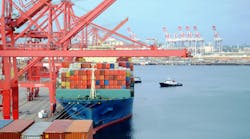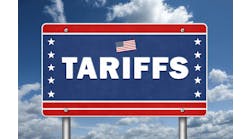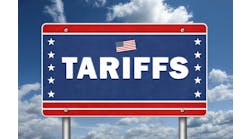The good news is that the congestion and service failures that plagued North American port operations for several years have finally receded. The bad news for port terminal operators is that they are suffering from financial constraints resulting from the fact that they no longer collect large and container detention and demurrage charges they imposed during the crisis.
“As COVID-related restrictions began to expire, we have observed softer cargo volumes across several marine trade lanes, as the National Retail Federation forecasts declining U.S. imports at least for the next several months as the current inflationary market has slowed down overall consumer discretionary spending,” report Luiz Gosling, Marc Iampieri and Brian Nemeth of the AlixPartners consulting firm.
In addition, U.S. imports from Asia have diminished in recent months, and experts believe this trend will continue to decline from the previous peaks of recent record-setting and near-record levels. Ocean imports have dried up in the face of economic headwinds, and inland warehouses are full
Port traffic is likely to come to a near halt if the International Longshore and Warehouse Union (ILWU) and West Coast terminal operators fail to reach a multi-year labor contract before March is over, following eight months of ongoing contract negotiations. The negotiators have been characteristically tight-lipped about the issues discussed, but if past is prologue, the talks most likely stem from the union’s opposition to port automation and reluctance to reduce crew sizes.
U.S. port traffic, as well as domestic freight traffic numbers, are usually depressed in the early months of the new year. However, in this case, the numbers have been nothing less than abysmal.
The AlixPartners consultants said they learned at recent industry meetings that ocean freight customers are in the throes of a difficult situation that promises a complicated immediate future for them. This sentiment appears to be anchored in the continuing pressure on global seaborne trade volumes coupled with pushback on accessorial costs.
AlixPartners recently surveyed a sample of its clients to investigate the other side of the value chain. In doing so, they sought to understand how these companies managed their container volumes and accessorial costs in 2022 relative to 2021, and what the expectations should be as 2023 proceeds.
The consultants observed that Container Storage Time—a key metric for demurrage and detention revenue—has shown sequential erosion between 2021 and 2022. In fact, 38% of the survey respondents indicated shorter time spent at the port in 2022 versus the previous year, and 56% indicated shorter time spent outside the port.
The amount of spend with Container Demurrage and Detention Cost decreased between 2021 and 2022 for 63% of the survey respondents, with expectations of an accelerated decline of ocean traffic to the U.S. as is measured by early 2023 National Retail Federation (NRF) Port Tracker monthly reports.
Where Are Solutions?
While many factors drive the terminal operators to rely on demurrage and accessorial fees as revenue generators, the reasons for the decline identified in the AlixPartners survey commentary stems from three areas, according to consultants Gosling, Iampieri and Nemeth:
• Efforts to renegotiate base freight rates and accessorial rates and terms (i.e., free days) with container operators, third-party logistics providers (3PLs), multimodal providers and freight forwarders.
• Improving operational efficiency through better load consolidation, better freight planning (thus mitigating the effect of expedited shipments and urgent loads), or change in trade lanes and lane mix, ultimately resulting in less overall volume in the network.
• Improved operational agility coming from enhancing internal processes. These efforts include leveraging data to improve visibility, and implementing a stronger diligence to take containers out of the ports faster and—upon reaching its destination—unloading and reverting the container as quickly as possible, thus potentially avoiding unnecessary detention and demurrage fees.
The consultants believe terminal operators can help themselves by adopting several basic strategies to help insulate their financials from these ongoing trends. One way is finding ways to improve operational efficiency after leaving behind the congestion suffered by North American ports, which did not operate very efficiently in the wake of an unexpected volume surge.
They observed, “Terminals in the West Coast were particularly affected by low yard and gate productivity in face of extreme utilization (i.e., above 85%), which either generated or catalyzed crew overtime, low equipment availability, limited planning visibility, longer wait times, and even operational issues such as shrinkage and maintenance overload.”
Of courses, the terminal operators’ previous collective bargaining agreement with the ILWU workers was a major contributor to depressing the terminals’ operational productivity, and there are no indications that the new agreement will see any significant improvement in this area.
“Moreover, while container yards and gates effectively act as lungs to the operational body, we also see opportunity for container terminals to invest time and effort on marine, rail and maintenance operations, ensuring they are well planned and as productive as possible since those are large drivers of labor cost,” the consultants added.
They also point out that while the expected decrease in volume might have an impact in the overall operation of terminals and 3PLs, these companies must seize this opportunity to boost operating metrics up to pre-COVID levels and unlock additional cost-saving opportunities, which should mitigate some of the earnings erosion in the horizon.
Certain kinds of financial legerdemain could help alleviate some of this, the AlixPartners consultants explain. A potential hedge against rate fluctuation and ancillary revenue erosion might lie in service specialization, as operations tend to be more reliant on additional charges, such as transloading, demurrage and detention, they suggest.
“However, as evidenced by our survey, large shippers might have ongoing initiatives to mitigate such operational constraints through their own internal decisions and process improvements, which makes this not a long-term solution. All in all, developing value-added services such as express gate lanes and improved yard visibility for pick-ups can be profitable avenues for operators looking to differentiate themselves from peers on the same coast or region in 2023.”
Gosling, Iampieri and Nemeth also stressed that it is crucial for terminal investors and owners “to know specifically where their competitive strength lies, and to determine whether their challenge is to begin making initial efforts and investments or to double down on previous moves so they can fully exploit the opportunity to improve the business.”




